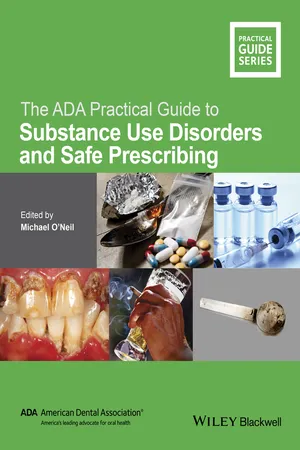
The ADA Practical Guide to Substance Use Disorders and Safe Prescribing
- English
- ePUB (mobile friendly)
- Available on iOS & Android
The ADA Practical Guide to Substance Use Disorders and Safe Prescribing
About This Book
Dentists have been inundated by patients with an array of complicated medical conditions and pain/sedation management issues. This is in addition to a variety of legal regulations dentists must follow regarding the storage and recordkeeping of controlled substances. Avoid unknowingly putting your practice at risk by becoming victim to a scam or violating a recordkeeping requirement with The ADA Practical Guide to Substance Use Disorders and Safe Prescribing.
This Practical Guide is ideal for dentists and staff as they navigate:
•Detecting and deterring substance use disorders (SUD) and drug diversion in the dental office (drug-seeking patients)
•Prescribing complexities
•Treating patients with SUD and complex analgesic and sedation (pain/sedation management) needs and the best use of sedation anxiety medication
•Interviewing and counselling options for SUD
•Federal drug regulations
Commonly used illicit, prescription, and over-the-counter drugs, as well as alcohol and tobacco, are also covered.
Special features include:
•Clinical tools proven to aid in the identification, interviewing, intervention, referral and treatment of SUD
•Basic elements of SUD, acute pain/sedation management, and drug diversion
•Summary of evidence-based literature that supports what, when and how to prescribe controlled substances to patients with SUD
•Discussion of key federal controlled substance regulations that frequently impact dental practitioners
•Checklists to help prevent drug diversion in dental practices
•Chapter on impaired dental professionals
•Case studies that examine safe prescribing and due diligence
Frequently asked questions
Information
1
Substance Use Disorders, Drug Diversion, and Pain Management: The Scope of the Problem
HARMDIntroduction
Box 1.1 Factors Complicating the Practice of General Dentistry
- Chronic pain management.
- Misuse of prescription medication.
- SUD associated with prescription medications.
- SUD associated with illicit substances.
- SUD associated with alcohol.
- Psychiatric disorders (diagnosed and undiagnosed).
- Opioid maintenance treatment programs (methadone, buprenorphine).
- Aging population.
- Polypharmacy (use of multiple medications to treat the same condition).
- Patient criminal activity.
Definitions
Acute Pain
Addiction
Chronic Pain
Drug Diversion
Drug Misuse
Opiates and Opioids
Prescriber–Patient Mismatch
Substance Abuse
Substance Abuse is a maladaptive pattern of chemical use (e.g. alcohol, medications, marijuana, cocaine, solvents, etc.) leading to clinically significant impair...
Table of contents
- Cover
- Dedication
- Title page
- Copyright
- Contributors
- Preface
- Acknowledgments
- 1 Substance Use Disorders, Drug Diversion, and Pain Management: The Scope of the Problem
- 2 Understanding the Disease of Substance Use Disorders
- 3 Principles of Pain Management in Dentistry
- 4 Special Pain Management Considerations: (1) Chronic Methadone, Buprenorphine, and Naltrexone Therapy; (2) Chronic Opioids for Nonmalignant Pain
- 5 Sedation and Anxiolysis
- 6 Common Substances and Medications of Abuse
- 7 Tobacco Cessation: Behavioral and Pharmacological Considerations
- 8 Detection and Deterrence of Substance Use Disorders and Drug Diversion in Dental Practice
- 9 Interviewing and Counseling Patients with Known or Suspected Substance Use Disorders: Dealing with Drug-seeking Patients
- 10 Office Management of Controlled Substances
- 11 Addiction and Impairment in the Dental Professional
- 12 Due Diligence and Safe Prescribing
- The ADA Practical Guide to Substance Use Disorders and Safe Prescribing
- Index
- EULA